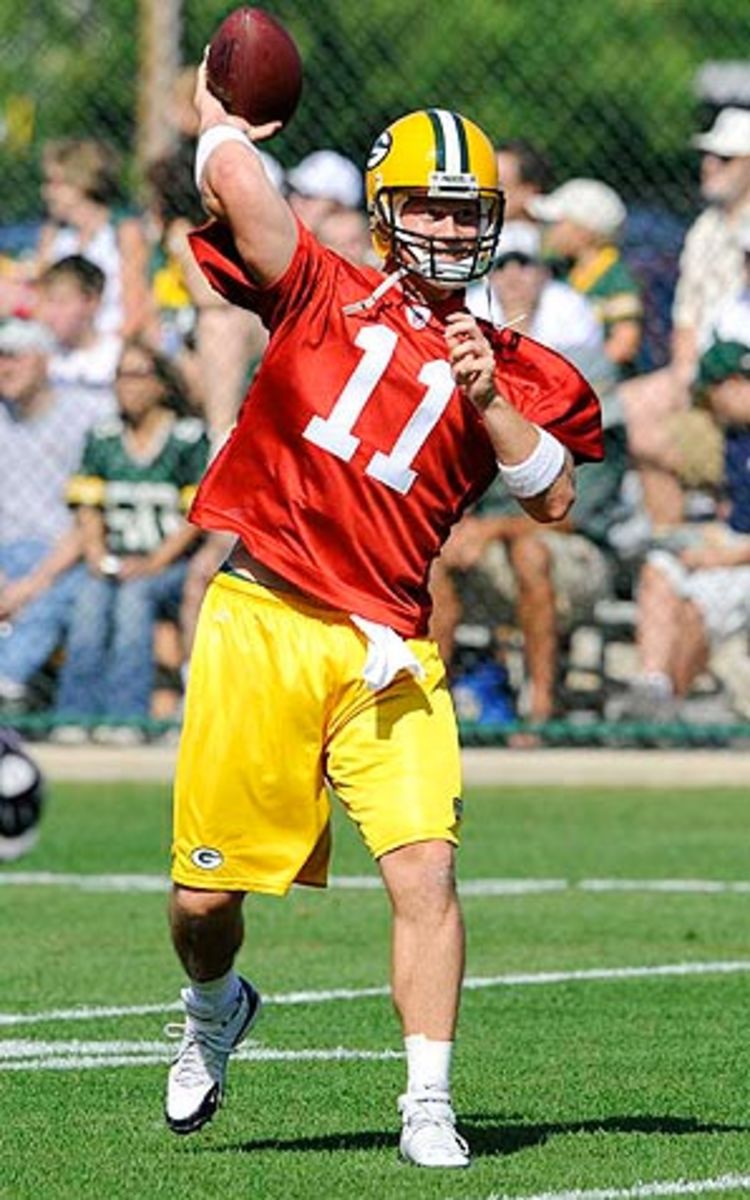How Packers offseason might have unfolded if Favre had not 'retired'
But which of Green Bay's offseason decisions might have turned out differently had Favre never walked away in the first place? If they knew then what they know now, how would the Packers have approached their personnel judgments of the past six months?
According to a team official I talked to Monday, probably pretty similarly to what actually transpired, with one notable exception. With Favre still around, Green Bay almost certainly wouldn't have invested a second-round pick -- the 56th overall -- in Louisville quarterback Brian Brohm.
After going 13-3 and winning a divisional-round playoff game last season, the Packers largely stood pat and weren't really players in free agency. In addition, Favre's on-again, off-again retirement saga had no adverse effect on Green Bay's salary cap situation, which was considered healthy with or without No. 4 in the picture in '08.
But Favre's vacillation certainly had an impact on the Packers' draft. Green Bay, of course, drafted two quarterbacks in April, taking Brohm and then LSU's Matt Flynn with its first seventh-round selection, No. 209 overall. A depth chart of Favre, 2005 first-round pick Aaron Rodgers and Flynn, a developmental-type prospect, would have made sense for 2008 in Green Bay. But spending a valuable second-rounder on Brohm, in order to give themselves an insurance policy against Rodgers' modest NFL track record, now looks like a luxury the Packers couldn't afford.
Favre's presence even for one more year would have changed the focus of the Packers' quarterback search this offseason, with Green Bay only interested in spending a mid-to-late round pick on a young passer. The Packers, according to a team source with insight into Green Bay's thinking this year, might not have waited until the seventh round to take a potential No. 3 quarterback. But they wouldn't have spent anything higher than a fourth or fifth-rounder on a passer to groom behind Favre and Rodgers.
But if Brohm isn't as necessary with Favre having resumed his career, the logical next question -- hypothetical as it may be -- is to wonder where Green Bay would have spent its second-round pick if not at quarterback? Several positions of need would have moved higher up the pecking order, and in each case, the Packers eventually got around to spending a pick there: Cornerback, tight end, offensive tackle and defensive line.
• Cornerback: Just after selecting Brohm, the Packers took Auburn cornerback Pat Lee with the 60th overall pick, their second choice of the second round. The reasoning behind Lee's selection was straightforward: Starting cornerbacks Charles Woodson (31) and Al Harris (33) are entering their 11th NFL seasons. But whether he went 56th in Brohm's spot, or four slots later at 60th, Lee would likely have been the Packers' choice given that another quarterback (Miami's Chad Henne), a receiver (Tampa Bay's Dexter Jackson) and a center (Indy's Mike Pollak) went in the three spots between Green Bay's two second-rounders.
• Tight end: Having lost veteran Bubba Franks during free agency, the Packers were shopping for another tight end. They took Jermichael Finley of Texas in the third round, 91st overall. But having the No. 56 pick to burn without the selection of Brohm, Green Bay would have been in position to take the much higher rated Martellus Bennett of Texas A&M, who went No. 61 to Dallas in the second round.
• Offensive tackle: The Packers two starting tackles, Chad Clifton and Mark Tauscher are 32 and 31, respectively, and entering their ninth NFL seasons. Health has been an issue of late for both, which is one reason Green Bay spent a late fourth-round pick on Central Florida tackle/guard Josh Sitton, and a fifth-round pick on Louisville tackle Breno Giacomini.
Tackle prospects who came off the draft board between Green Bay's No. 56 pick in the second round and the 135th pick that it used on Sitton include Toledo's John Greco (Rams at No. 65), Kansas's Anthony Collins (Bengals at No. 112), Texas's Tony Hills (Steelers at No. 130), and Weber State's David Hale (Ravens at No 133).
• Defensive line: The Packers believe in depth on the defensive line, and they used a high fourth-round pick (No. 102) to select Wake Forest defensive end Jeremy Thompson after trading defensive tackle Corey Williams to the Browns earlier in the offseason.
Had Green Bay had its No. 56 pick to spend on its D-line, players who would have been available included Hampton defensive end Kendall Langford (Dolphins at No. 66), Virginia Tech end Chris Ellis (Bills at No. 72), Auburn tackle Pat Sims (Bengals at No. 77), and Arkansas tackle Marcus Harrison (Bears at No. 90).





